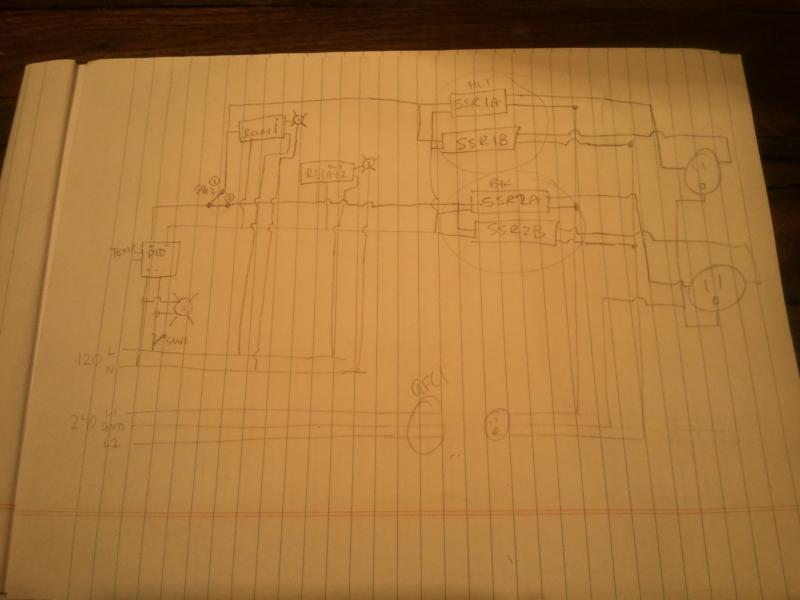Im currently in the design phase of my ebrewery. Exciting stuff cant wait to start brewing in my basement.
If anyone has any comments or ideas to share please by all means.
Im somewhat following Kal's design but am scaling back where I can.
Here is an overview of the system im proposing, ive deviated from some of the other designs based on what parts I have on hand (ie: several SSR's, relays, etc).
Power is fed from my 100A fuse panel to a 30A fused 8/4 cable. From there im goin to install a box with a 30A 3 wire outlet (note im not using the neutral for the "power" portion of the design). I purchased a TRC 30A 10/3 GFCI cable, which i will install a similar 30A 3wire male connector on either end. This will then connect to my "power box".
I will have a 5500w 240element in both the HLT and BK. One PID will control both (manual control for the BK, the thermocouple will reside in the HLT).
Within the powerbox there will be (4) 25A 240V solid state relays.
The idea would be:
SSR-BK-1 switches Line 1 in the BK
SSR-BK-2 switches Line 2 in the BK
SSR-HLT-1 switches Line 1 in the HLT
SSR-HLT-2 switches Line 2 in the HLT
The 24V control signal from the PID will be diverted via a selector switch to either SSR-BK1 & SSR-BK2, or SSR-HLT1 & SSR-HLT2. So only 1 element can be energized at a given time.
There will be a main disconnect switch installed in the "power box".
The power for the "control box" will be fed via a 15A GFCI protected circuit. (As the 30A GFCI cable i purchased is only a 3 wire design, so no 120V). The control box will also house 2 relays which based on the PID output thru the selector switch will energize either the HLT or BK pilot light. 1 pump will also be fed using this 15A circuit and controlled via a toggle switch.
Im still determining how I can effectively kill both the 240V and 120V to the entire system with the use of a single E stop.
If anyone has any comments or ideas to share please by all means.
Im somewhat following Kal's design but am scaling back where I can.
Here is an overview of the system im proposing, ive deviated from some of the other designs based on what parts I have on hand (ie: several SSR's, relays, etc).
Power is fed from my 100A fuse panel to a 30A fused 8/4 cable. From there im goin to install a box with a 30A 3 wire outlet (note im not using the neutral for the "power" portion of the design). I purchased a TRC 30A 10/3 GFCI cable, which i will install a similar 30A 3wire male connector on either end. This will then connect to my "power box".
I will have a 5500w 240element in both the HLT and BK. One PID will control both (manual control for the BK, the thermocouple will reside in the HLT).
Within the powerbox there will be (4) 25A 240V solid state relays.
The idea would be:
SSR-BK-1 switches Line 1 in the BK
SSR-BK-2 switches Line 2 in the BK
SSR-HLT-1 switches Line 1 in the HLT
SSR-HLT-2 switches Line 2 in the HLT
The 24V control signal from the PID will be diverted via a selector switch to either SSR-BK1 & SSR-BK2, or SSR-HLT1 & SSR-HLT2. So only 1 element can be energized at a given time.
There will be a main disconnect switch installed in the "power box".
The power for the "control box" will be fed via a 15A GFCI protected circuit. (As the 30A GFCI cable i purchased is only a 3 wire design, so no 120V). The control box will also house 2 relays which based on the PID output thru the selector switch will energize either the HLT or BK pilot light. 1 pump will also be fed using this 15A circuit and controlled via a toggle switch.
Im still determining how I can effectively kill both the 240V and 120V to the entire system with the use of a single E stop.




